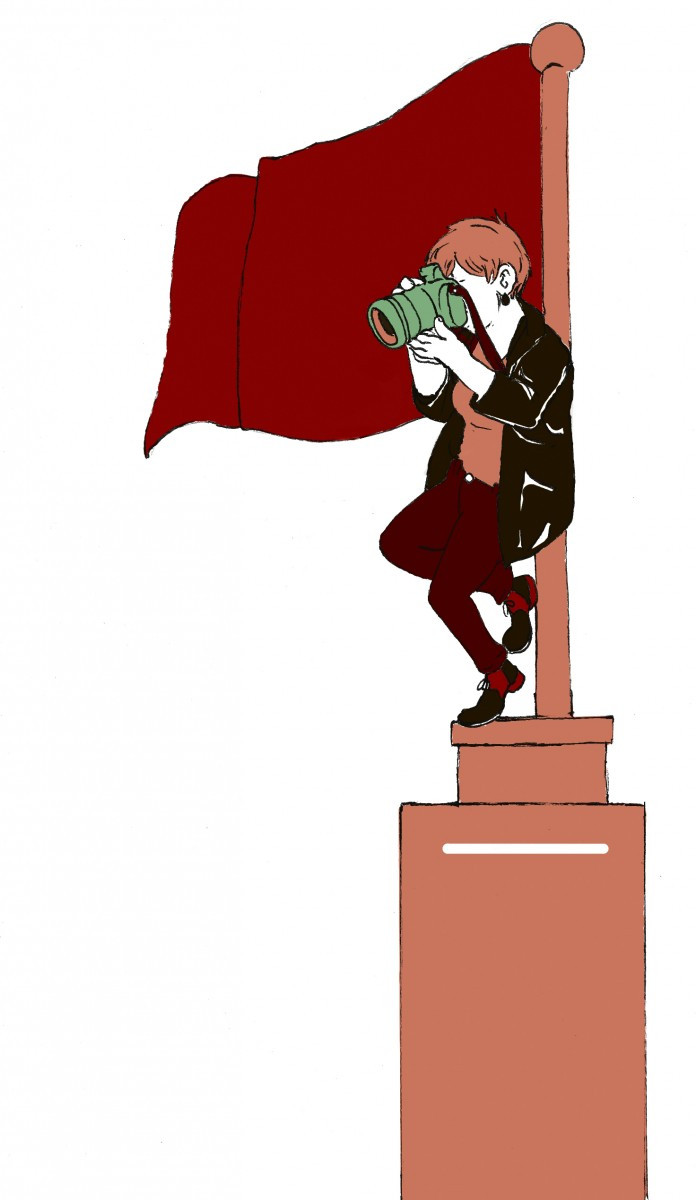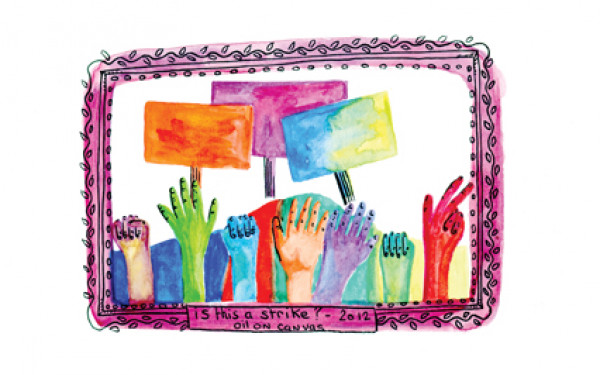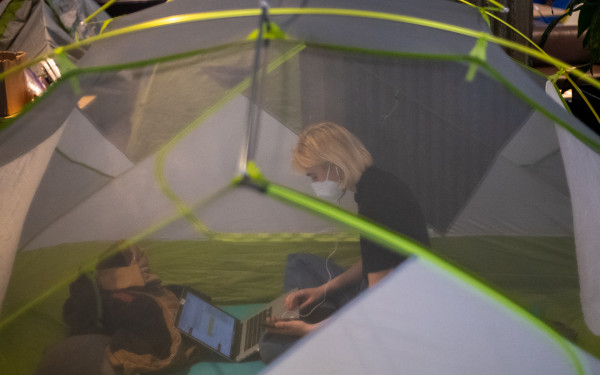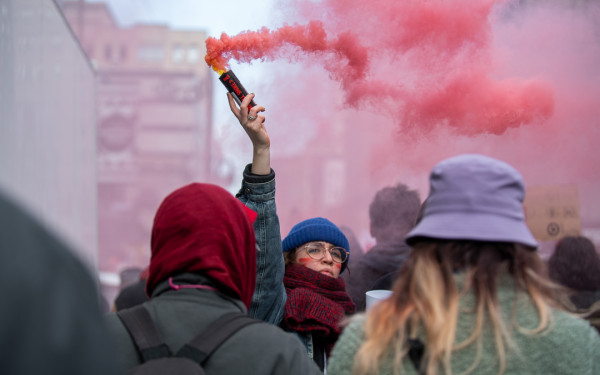The Maple Spring Revisited
Inside the Student Movement: A First-Hand Account of the 2012 Tuition Protests
All Media Democracy content is available on our Special Issue Microsite. Works best on Chrome or Firefox.
Of all the things I witnessed during the 2012 student strike, the most powerful image I can recall comes from the March 22 rally.
I was watching the crowd as it approached the Old Port when someone with a microphone yelled that the last group of demonstrators had just left Place du Canada, where the march had originated what felt like hours before.
The march was so massive that it had to travel almost five kilometres before everyone had cleared out its starting point.
To me, that’s what the strike was. It wasn’t about throwing rocks or setting fires, but about more than 200,000 people together on one day, peacefully marching to let the Charest government know that the scheduled tuition hike was, in a word, unacceptable.
Much of the media coverage of the strike—or boycott, as some chose to call it—was framed in a very negative way. Students were lazy, they were entitled, they ought to suck it up and fork over the cash. Tuition in Quebec was the lowest in the country, so why were people complaining?
Arguments that weren’t clearly thought through or relied on false information perverted the message that those who supported the strike were trying to send, much to students’ frustration.
Now that the protests have died down, it’s time to look back on what it was like to be out every night documenting the madness.
How Things Started
On March 7, 2012, the Concordia Student Union held a general assembly that ended in a majority vote supporting a one-week strike. Around this time, the anti-strike movement at school began, setting the tone for an emotionally charged few months.
On March 22, the first day of the Concordia strike, over 200,000 people from across the province marched peacefully through the city, denouncing the Charest government and the planned tuition hike.
While the school-wide strike only lasted a week, various individual departments, including my own—sociology—remained on strike for the remainder of the semester, and took varying degrees of action throughout.
Bill 78 and the Manifs du Soir
There were nights when things got out of control. After the adoption of Bill 78 on May 18, the nightly protests frequently got out of hand. Under the bill, all protests of 50 people or more required an itinerary be submitted to the police beforehand, and restrictions were put on where people could protest.
In short, it was an egregious bill that vastly reduced the right to assemble in an attempt to stamp out the ever-growing student movement.
“The strike wasn’t about throwing rocks or setting fires, but about more than 200,000 people together on one day, peacefully marching to let the Charest government know that the scheduled tuition hike was, in a word, unacceptable.”
— Erin Sparks, Link editor
Bill 78 changed the entire dynamic of protests. It made demonstrations illegal before they’d even started, and while some were permitted to proceed as long as no illegal acts were permitted, riot police quashed others after only a few minutes.
What could have otherwise been a night of peaceful protest would erupt into a flurry of pepper spray, CS gas and flashbangs. Hundreds were arrested en masse, including passersby and journalists.
I saw more than a few broken bank windows and there were individuals who seemingly went out of their way to instigate violence, both in uniform and not. At the same time, there were nights when hundreds marched until 4 a.m. without incident.
It was hard not to look at the police as a provoking force during the nighttime protests—more often than not, it seemed overzealous police had been the ones escalating things, not the demonstrators.
Despite the occasional burst of violence, looking at the student movement as something fuelled by people looking to start a fight is unfair.
In reality, it was a movement spurred on by people who saw the hikes as dangerous, as something that was going to make it harder to get a university education, while simultaneously feeding into a system of corruption and financial mismanagement. It was a movement made up of both students and those who hadn’t sat in a classroom for years.
Like every social movement, its members existed on a spectrum ranging from the militant activist to the casual protester, and classifying the strike as something lead by a gang of entitled, iPhone-toting brats is irresponsible and plain wrong.
Technology and the Strike
Social media, Twitter in particular, played a heavily significant role in the student movement. A volley of hashtags, like the still-popular #manifencours, were born, and it became easier than ever before to organize, track and meet up with an ongoing protest.
Twitter was used to both help people evade arrest and prevent themselves from getting swept up in something they didn’t want to participate in. Protests became trackable through an Android app developed during the strike, and a Google map was created to compile actions taken by striking students, such as the placement of red squares on various Montreal landmarks like the Mount Royal Cross.
There were also instances of journalists using Twitter as a guardian angel to avoid arrest. On May 17, along with other members of The Link and The McGill Daily, I was kettled alongside a dozen or so other people, some of whom were not even involved in the protest.
Upon being denied release by the police guarding the kettle (despite the presence of press passes), we began calling for help on the Twittersphere, tweeting our situation.
Just after 2 a.m., they were about to process Link reporter and photographer Pierre Chauvin when we were released after a Twitter exchange with the SPVM. Justin Ling, a freelancer working for OpenFile at the time, had a similar experience.
C’est Pas Une Offre, C’est Une Insulte
Few attempts were made by then-Premier Jean Charest to appease striking students, and what attempts were made, like the offer to stretch the proposed hike over seven years rather than five, were only met with more protesting, with students seeing the offer as an insult.
Aug. 1 marked both the 100th nightly protest and the announcement of a provincial election. The demonstration was largely peaceful, and there was a strong sense of hope from those marching. Maybe, after all of the pot-banging and marching it was really over.
On Sept. 4, the Parti Québécois came to power and the proposed hike was cancelled along with Bill 78 (though much of its effect remained in Montreal in a slightly different form as municipal bylaw P-6). Under the Marois government, tuition is now indexed to the cost of living, something that raises questions about whether or not students really did win.
Issues of police brutality surfaced during the student movement, and the troubling absence of the police union from the Ménard Commission, the inquiry into the events of the strike, means that police who committed violent acts likely won’t be held accountable.
Class action lawsuits have been filed against the city for the mass arrest and heavy use of kettling during the strike, but the actions of individual officers have gone unpunished, setting a terrifying precedent.
The student movement, which was so central—and polarizing—to the lives of so many Quebecers, and so captivating to those outside the province, arguably ended over a year ago with the cancellation of the Liberal Party’s hike.
But its effects are still resonating in Montreal, and likely will continue for a long time.




_600_375_s_c1.png)

